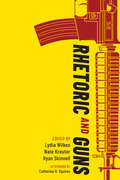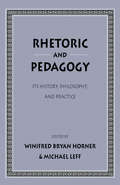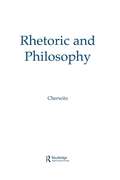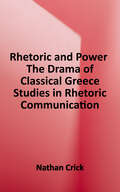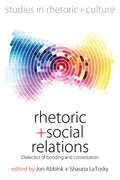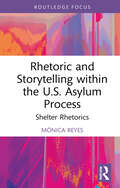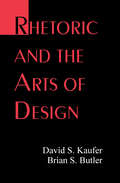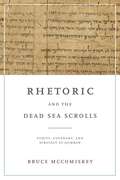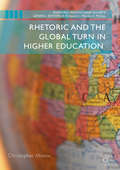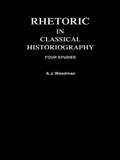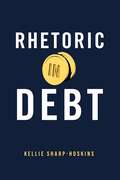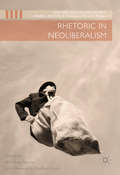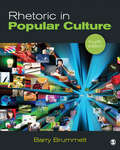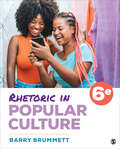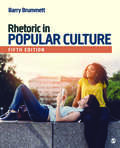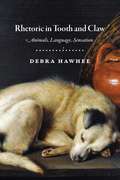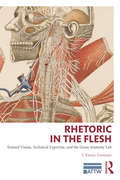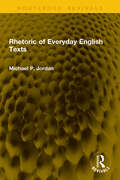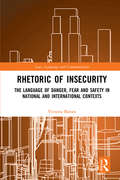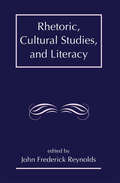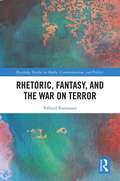- Table View
- List View
Rhetoric and Guns
by Ryan Skinnell Lydia Wilkes Nate KreuterGuns hold a complex place in American culture. Over 30,000 Americans die each year from gun violence, and guns are intimately connected to issues of public health, as is evident whenever a mass shooting occurs. But guns also play an important role in many Americans’ lives that is not reducible to violence and death—as tools, sporting equipment, and identity markers. They are also central to debates about constitutional rights, as seen in ongoing discussions about the Second Amendment, and they are a continuous source of legislative concern, as apparent in annual ratings of gun-supporting legislators. Even as guns are wrapped up with other crucial areas of concern, they are also fundamentally a rhetorical concern. Guns and gun violence occupy a unique rhetorical space in the United States, one characterized by silent majorities, like most gun owners; vocal minorities, like the firearm industry and gun lobby; and a stalemate that fails to stem the flood of the dead. How Americans talk, deliberate, and fight about guns is vital to how guns are marketed, used, and regulated. A better understanding of the rhetorics of guns and gun violence can help Americans make better arguments about them in the world. However, where guns are concerned, rhetorical studies is not terribly different from American culture more generally. Guns are ever-present and exercise powerful effects, but they are commonly talked about in oblique, unsystematic ways. Rhetoric and Guns advances more direct, systematic engagement in the field and beyond by analyzing rhetoric about guns, guns in rhetoric, and guns as rhetoric, particularly as they relate to specific instances of guns in culture. The authors attempt to understand rhetoric’s relationship to guns by analyzing rhetoric about guns and how they function in and as rhetoric related to specific instances—in media coverage, political speech, marketing, and advertising. Original chapters from scholars in rhetorical studies, communication, education, and related fields elucidate how rhetoric is used to maintain and challenge the deadly status quo of gun violence in the United States and extend rhetoricians’ sustained interest in the fields’ relationships to violence, brutality, and atrocity. Contributors: Ira J. Allen, Brian Ballentine, Matthew Boedy, Peter Buck, Lisa Corrigan, Rosa Eberly, Kendall Gerdes, Ian E. J. Hill, Nathalie Kuriowa-Lewis, Patricia Roberts-Miller, Craig Rood, Bradley Serber, Catherine R. Squires, Scott Gage
Rhetoric and Pedagogy: Its History, Philosophy, and Practice: Essays in Honor of James J. Murphy (Rhetoric And Public Affairs Ser.)
by Winifred Bryan Horner Michael LeffTo provide a view of the history of western rhetoric, this volume presents original articles by a number of world-renowned scholars representing different countries and varying viewpoints. In discussing the status of the historical perspectives on rhetoric, these international scholars also present a tribute to James J. Murphy, whose scholarship and service did much to shape the field. The book will introduce new insights into western European rhetoric and its connections with English rhetoric.
Rhetoric and Philosophy
by Richard A. CherwitzThis important volume explores alternative ways in which those involved in the field of speech communication have attempted to find a philosophical grounding for rhetoric. Recognizing that rhetoric can be supported in a wide variety of ways, this text examines eight different philosophies of rhetoric: realism, relativism, rationalism, idealism, materialism, existentialism, deconstructionism, and pragmatism. The value of this book lies in its pluralistic and comparative approach to rhetorical theory. Although rhetoric may be the more difficult road to philosophy, the fact that it is being traversed by a group of authors largely from speech communication demonstrates important growth in this field. Ultimately, there is recognition that if different thinkers can have solid reasons to adhere to disparate philosophies, serious communication problems can be eliminated. Rhetoric and Philosophy will assist scholars in choosing from among the many philosphical starting places for rhetoric.
Rhetoric and Power: The Drama of Classical Greece (Studies in Rhetoric/Communication Series)
by Nathan CrickAn examination of how intellectuals and artists conceptualized rhetoric as a medium of power in a dynamic age of democracy and empire. <p><p> In Rhetoric and Power, Nathan Crick dramatizes the history of rhetoric by explaining its origin and development in classical Greece, beginning with the oral displays of Homeric eloquence in a time of kings, following its ascent to power during the age of Pericles and the Sophists, and ending with its transformation into a rational discipline with Aristotle in a time of literacy and empire. Crick advances the thesis that rhetoric is primarily a medium and artistry of power, but that the relationship between rhetoric and power at any point in time is a product of historical conditions, not the least of which is the development and availability of communication media. <p><p>Investigating major works by Homer, Heraclitus, Aeschylus, Protagoras, Gorgias, Thucydides, Aristophanes, Plato, Isocrates, and Aristotle, Rhetoric and Power tells the story of the rise and fall of classical Greece while simultaneously developing rhetorical theory from the close criticism of particular texts. As a form of rhetorical criticism, this volume offers challenging new readings to canonical works such as Aeschylus's Persians, Gorgias's Helen, Aristophanes's Birds, and Isocrates's Nicocles by reading them as reflections of the political culture of their time. Through this theoretical inquiry, Crick uses these criticisms to articulate and define a plurality of rhetorical genres and concepts, such as heroic eloquence, tragicomedy, representative publicity, ideology, and the public sphere, and their relationships to different structures and ethics of power, such as monarchy, democracy, aristocracy, and empire. <p><p>Rhetoric and Power thus provides a foundation for rhetorical history, criticism, and theory that draws on contemporary research to prove again the incredible richness of the classical tradition for contemporary rhetorical scholarship and practice.
Rhetoric and Social Relations: Dialectics of Bonding and Contestation (Studies in Rhetoric and Culture #8)
by Jon Abbink Shauna LaToskyThis volume explores the constitutive role of rhetoric in socio-cultural relations, where discursive persuasion is so important, and contains both theoretical chapters as well as fascinating examples of the ambiguities and effects of rhetoric used (un)consciously in social praxis. The elements of power, competition and political persuasion figure prominently. It is an accessible collection of studies, speaking to common issues and problems in social life, and shows the heuristic and often explanatory value of the rhetorical perspective.
Rhetoric and Storytelling within the U.S. Asylum Process: Shelter Rhetorics (Routledge Studies in Rhetoric and Communication)
by Mónica ReyesThis book explores the U.S. asylum process and how those seeking shelter deal with the rhetorical pressures of compelling asylum narratives they need to write in order to stay.Centered around a study conducted at a shelter on the U.S. border, this book moves beyond this context to demonstrate how liminal sites provide opportunities for displaced communities to employ distinct shared rhetorical practices of daily life—like silence and routine—that both safeguard vulnerabilities and enact agency for individuals within precarious spaces. Placing people who seek asylum and those who work with them as rhetorical and socio-cultural experts on this issue, the study adds to the emerging importance of rhetoric within discussions of asylum and forced migration and demonstrates the significance of rhetorical ecology theory as part of a blended methodology in understanding people seeking asylum as a group in a perpetual and explicit state of ethos development.Highlighting the need for support which is sensitive to the narrative struggles people seeking asylum face, this book will have important findings for scholars and upper-level students of cultural rhetorics, feminist rhetoric, migration studies, political science, and intercultural communication.
Rhetoric and Wonder in English Travel Writing, 1560-1613
by Jonathan P.A. SellRhetoric and Wonder in English Travel Writing, 1560-1613, shows how rhetorical invention, elocution and ethos combined to create plausible representations by generating intellectual and emotional significances which, meaningful in consensual terms, were 'consensually' true. However, some traveller-writers betrayed an unease with such representation, rooted as it was in a metaphorical epistemology out of kilter with an increasingly empiricist age. This book throws new light onto the episteme shift that ushered in modernity with its distrust of metaphor in particular and rhetoric's 'wordish descriptions' in general. In response to the empirical desiderata of scientific rationalism, traveller-writers textually or physically made their own bodies available as evidence of their encounters with wonder, thus transforming themselves into wonderful objects. The irony is that, far from dispensing with rhetoric, they merely put the accent on its more dramatic arts of gesture and action. The body's evidence could still be doctored, but its illusory truths were better able to satisfy the empirical demand for 'ocular proof'. The author's main purposes here are to complement, and sometimes counter, recent work on early modern travel literature by concentrating on its use of rhetoric to communicate meaning; and to suggest how familiarity with the workings of rhetoric and its communicative and epistemological premises may enhance readings of early modern English literature generally.
Rhetoric and the Arts of Design
by David S. Kaufer Brian S. ButlerThe design arts -- from the design of buildings and machines to software and interfaces -- are associated with types of knowledge and performance thought to be structured, modular, and systematic. Such arts have become increasingly prestigious in our technocratic society. Since Aristotle, the art of rhetoric was conceived as a loosely structured "practical" art thought to be limited in the extent to which it could mimic more precise subject matters. The art of rhetoric has been controversial since classical times, but its status has sunk even lower since the industrial revolution -- a point when civic cultures began to cede authority and control to the cultures of specialized experts. Many sympathizers of rhetoric have resisted its decline by calling for a civic art of public discourse to stand in opposition to a technocratic specialized discourse that has come, increasingly, to disenfranchise the ordinary citizen. This is the first book to question the rhetoric/technical knowledge split from a more fundamental perspective. To get some perspective on what is at stake in rhetoric's traditional classification as a "practical" art, the authors: * explore the distinction between practical and design arts; * enumerate the various criteria cited in the literature for qualifying a cluster of knowledge and performative skills to count as an art of design; * show how the knowledge and performative skills associated with the art of rhetoric meet the major requirements of design knowledge; * propose a general architecture of rhetorical design, one descriptive both of civic address and specialized academic argument; * turn to the Lincoln/Douglas debates to embody and provide some empirical support and illustration for their architecture; * demonstrate how Lincoln and Douglas can be thought of as expert designers whose rhetoric is highly structured and modular; and * explain how the rhetoric of both rhetorical agents can be represented in the layers and modules that one needs to display plans for buildings, software, or other design artifacts. These layers and modules are not just post hoc annotations of the debates; they also illuminate new and systematic ways for viewing the debates -- and by implication, other specimens of rhetoric -- in terms of strategies of artistic production. Kaufer and Butler conclude their presentation by citing some of the research and educational implications that follow from housing rhetoric within the family of design arts.
Rhetoric and the Dead Sea Scrolls: Purity, Covenant, and Strategy at Qumran
by Bruce McComiskeyDiscovered in 1947, the Dead Sea Scrolls are a collection of ancient Israelite documents, many of which were written by a Jewish sectarian community at Qumran living in self-exile from the priesthood of the Second Temple. This first book-length study of the rhetoric of these texts illustrates how the Essenes employed different rhetorics over time as they struggled to understand God’s word and their mission to their people, who seemed to have turned away from God and his purposes.Applying methods of rhetorical analysis to six substantive texts—Miqṣat Maʿaśeh ha-Torah, Rule of the Community, Damascus Document, Purification Rules, Temple Scroll, and Habakkuk Pesher—Bruce McComiskey traces the Essenes’ use of rhetorical strategies based on identification, dissociation, entitlement, and interpretation. Through his analysis, McComiskey uncovers a unique, fascinating story of an ancient religious community that had sought to reintegrate into Temple life but, dejected, instead established itself as the new covenant people of God for this world, only to turn ultimately to a trust in a metaphysical afterlife.Presenting forms of ancient Jewish rhetoric largely uninfluenced by classical rhetoric, this book broadens our understanding of human and religious rhetorical practice, even as it provides new insight into the events that led to the emergence of the Talmudic period. Rhetoric and the Dead Sea Scrolls will be useful to scholars working in the fields of religious rhetoric, Jewish studies, and early Christianity.
Rhetoric and the Dead Sea Scrolls: Purity, Covenant, and Strategy at Qumran
by Bruce McComiskeyDiscovered in 1947, the Dead Sea Scrolls are a collection of ancient Israelite documents, many of which were written by a Jewish sectarian community at Qumran living in self-exile from the priesthood of the Second Temple. This first book-length study of the rhetoric of these texts illustrates how the Essenes employed different rhetorics over time as they struggled to understand God’s word and their mission to their people, who seemed to have turned away from God and his purposes.Applying methods of rhetorical analysis to six substantive texts—Miqṣat Maʿaśeh ha-Torah, Rule of the Community, Damascus Document, Purification Rules, Temple Scroll, and Habakkuk Pesher—Bruce McComiskey traces the Essenes’ use of rhetorical strategies based on identification, dissociation, entitlement, and interpretation. Through his analysis, McComiskey uncovers a unique, fascinating story of an ancient religious community that had sought to reintegrate into Temple life but, dejected, instead established itself as the new covenant people of God for this world, only to turn ultimately to a trust in a metaphysical afterlife.Presenting forms of ancient Jewish rhetoric largely uninfluenced by classical rhetoric, this book broadens our understanding of human and religious rhetorical practice, even as it provides new insight into the events that led to the emergence of the Talmudic period. Rhetoric and the Dead Sea Scrolls will be useful to scholars working in the fields of religious rhetoric, Jewish studies, and early Christianity.
Rhetoric and the Global Turn in Higher Education (Rhetoric, Politics And Society Ser.)
by Christopher MinnixThis book studies the role of rhetoric in the expansive movement for global higher education in U.S. colleges and universities. Drawing on an analysis of how discourses of security, economy, and ethics shape the rhetoric of global higher education, as well as that of its populist and nationalist critics, the author argues for an understanding of global higher education as a site of rhetorical conflict over visions of students as citizens. In doing so, the work advances the project of transnational rhetorical education, a theoretical and pedagogical project that can foster forms of rhetorical inquiry, performance, and ethics that equip students to pursue transnational forms of civic engagement, belonging, and resistance. This book will be of interest to scholars and students in the fields of rhetoric and composition studies, communication, and education, as well as to faculty and administrators working in global higher education or internationalization programs.
Rhetoric in Classical Historiography: Four Studies
by A.J. WoodmanThis radical study argues against the view that the historian's craft has remained largely unchanged since classical times. Includes detailed discussion of the work of Thucydides, Cicero, Sallust, Livy and Tacitus.
Rhetoric in Debt (RSA Series in Transdisciplinary Rhetoric)
by Kellie Sharp-HoskinsIn recent years, household indebtedness in the United States reached its highest levels in history. From mortgages to student loans, from credit card bills to US deficit spending, debt is widespread and increasing.Drawing on scholarship from economics, accounting, and critical rhetoric and social theory, Kellie Sharp-Hoskins critiques debt not as an economic indicator or a tool of finance but as a cultural system. Through case studies of the student-loan crisis, medical debt, and the abuses of municipal bonds, Sharp-Hoskins reveals that debt is a rhetorical construct entangled in broader systems of wealth, rule, and race. Perhaps more than any other social marker or symbol, the concept of “debt” indicates differences between wealthy and poor, productive and lazy, secure and risky, worthy and unworthy. Tracking the emergence and work of debt across temporal and spatial scales reveals how it exacerbates vulnerabilities and inequities under the rhetorical cover of individual, moral, and volitional calculation and equivalency.A new perspective on a serious problem facing our society, Rhetoric in Debt not only reveals how debt organizes our social and cultural relations but also provides a new conceptual framework for a more equitable world.
Rhetoric in Neoliberalism
by Kim Hong NguyenThis volume examines and applies classical and contemporary concepts of rhetorical theory and criticism to the context of late capitalism. Each contributor shows how discourse, its subjects, and power relations are irrevocably transformed by neoliberalism. The collection analyzes a range of discourses and phenomena in neoliberalism including: higher education reforms, computational culture, Occupy Wall Street protests, the activism of Warren Buffett, and the 9-11 Truth Movement. Together, these chapters explore the contemporary rhetorical production of homo economicus and the various ways in which neoliberalism has become a way of thinking, orienting, and organizing all aspects of life around economized metrics of individualized and individuated success. This book will be of use to students and scholars crossing the fields of media and communication, political science, and sociology.
Rhetoric in Popular Culture
by Barry S. BrummettThe Fourth Edition of Barry Brummett’s Rhetoric in Popular Culture provides readers with in-depth insight into the techniques of rhetorical criticism to analyze the full spectrum of contemporary issues in popular culture. From movies, magazines and advertisements, to social networking sites, music videos and television shows, Dr. Brummett presents key rhetorical concepts and applies them with critical analysis to a variety of exciting examples drawn from today's popular culture. Moving from theory to practice throughout the text, Brummett links concepts in an easy-to-understand way. Rhetoric in Popular Culture covers the concept rhetoric, itself, as well as its place and dynamic change in history, and offers methods to effectively employ rhetorical criticism in daily life. The new edition includes pertinent critical essays and case studies that show readers how the critical methods discussed can be used to study the hidden rhetoric of extended texts, and more.
Rhetoric in Popular Culture
by Barry S. BrummettThe Sixth Edition of Barry Brummett’s Rhetoric in Popular Culture provides readers with in-depth insight into the techniques of rhetorical criticism to analyze the full spectrum of contemporary issues in popular culture. Exploring a wide range of mass media texts including advertisements, magazines, movies, television, popular music, and social media, Barry Brummett presents key rhetorical concepts and applies them with critical analysis to a variety of exciting examples drawn from today′s popular culture. Ideal for courses in rhetorical criticism, the new edition includes new and updated sample critical essays and case studies that demonstrate for readers how the critical methods discussed can be used to study the hidden rhetoric of popular culture.
Rhetoric in Popular Culture
by Barry S. BrummettThe Sixth Edition of Barry Brummett’s Rhetoric in Popular Culture provides readers with in-depth insight into the techniques of rhetorical criticism to analyze the full spectrum of contemporary issues in popular culture. Exploring a wide range of mass media texts including advertisements, magazines, movies, television, popular music, and social media, Barry Brummett presents key rhetorical concepts and applies them with critical analysis to a variety of exciting examples drawn from today′s popular culture. Ideal for courses in rhetorical criticism, the new edition includes new and updated sample critical essays and case studies that demonstrate for readers how the critical methods discussed can be used to study the hidden rhetoric of popular culture.
Rhetoric in Popular Culture: Brummett: Rhetoric In Popular Culture 4e + Brummett: Techniques Of Close Reading (Studies In Rhetoric And Communication)
by Barry S. Brummett“An accessible introduction to contemporary rhetorical theory and its applications in everyday life.” —Cory Brewster, Eastern Oregon University Rhetoric in Popular Culture, Fifth Edition, shows you how to apply growing and cutting-edge methods of critical studies to a full spectrum of contemporary issues seen in daily life. Exploring a wide range of mass media including current movies, magazines, advertisements, social networking sites, music videos, and television shows, Barry Brummett uses critical analysis to apply key rhetorical concepts to a variety of exciting examples drawn from popular culture. You are guided from theory to practice in an easy-to-understand manner, providing you with a foundational understanding of the definition and history of rhetoric as well as new approaches to the rhetorical tradition. The highly anticipated Fifth Edition includes new critical essays and case studies that demonstrate for you how the critical methods discussed can be used to study the hidden rhetoric of popular culture.
Rhetoric in Popular Culture: Brummett: Rhetoric In Popular Culture 4e + Brummett: Techniques Of Close Reading (Studies In Rhetoric And Communication)
by Barry S. Brummett“An accessible introduction to contemporary rhetorical theory and its applications in everyday life.” —Cory Brewster, Eastern Oregon University Rhetoric in Popular Culture, Fifth Edition, shows you how to apply growing and cutting-edge methods of critical studies to a full spectrum of contemporary issues seen in daily life. Exploring a wide range of mass media including current movies, magazines, advertisements, social networking sites, music videos, and television shows, Barry Brummett uses critical analysis to apply key rhetorical concepts to a variety of exciting examples drawn from popular culture. You are guided from theory to practice in an easy-to-understand manner, providing you with a foundational understanding of the definition and history of rhetoric as well as new approaches to the rhetorical tradition. The highly anticipated Fifth Edition includes new critical essays and case studies that demonstrate for you how the critical methods discussed can be used to study the hidden rhetoric of popular culture.
Rhetoric in Tooth and Claw: Animals, Language, Sensation
by Debra HawheeWe tend to think of rhetoric as a solely human art. After all, only humans can use language artfully to make a point, the very definition of rhetoric. Yet when you look at ancient and early modern treatises on rhetoric, what you find is surprising: they’re crawling with animals. With Rhetoric in Tooth and Claw, Debra Hawhee explores this unexpected aspect of early thinking about rhetoric, going on from there to examine the enduring presence of nonhuman animals in rhetorical theory and education. In doing so, she not only offers a counter-history of rhetoric but also brings rhetorical studies into dialogue with animal studies, one of the most vibrant areas of interest in humanities today. By removing humanity and human reason from the center of our study of argument, Hawhee frees up space to study and emphasize other crucial components of communication, like energy, bodies, and sensation. Drawing on thinkers from Aristotle to Erasmus, Rhetoric in Tooth and Claw tells a new story of the discipline’s history and development, one animated by the energy, force, liveliness, and diversity of our relationships with our “partners in feeling,” other animals.
Rhetoric in the Flesh: Trained Vision, Technical Expertise, and the Gross Anatomy Lab (ATTW Series in Technical and Professional Communication)
by T. Kenny FountainRhetoric in the Flesh is the first book-length ethnographic study of the gross anatomy lab to explain how rhetorical discourses, multimodal displays, and embodied practices facilitate learning and technical expertise and how they shape participants’ perceptions of the human body. By investigating the role that discourses, displays, and human bodies play in the training and socialization of medical students, T. Kenny Fountain contributes to our theoretical and practical understanding of the social factors that make rhetoric possible and material in technical domains. Thus, the book also explains how these displays, discourses, and practices lead to the trained perspective necessary for expertise. This trained vision is constructed over time through what Fountain terms embodied rhetorical action, an intertwining of body-object-environment that undergirds all scientific, medical, and technical work. This book will be valuable for graduate and advanced undergraduate courses in technical and professional communication (technical communication theory and practice, visual or multimodal communication, medical technical communication) and rhetorical studies, including visual rhetoric, rhetoric of science, medical rhetoric, material rhetoric and embodiment, and ethnographic approaches to rhetoric.
Rhetoric of Everyday English Texts (Routledge Revivals)
by Michael P. JordanFirst published in 1984, in Rhetoric of Everyday English Texts, the author uses over 100 short texts from educated writers in all walks of life to demonstrate that when we communicate there is a powerful unspoken linguistic consensus as to what is ‘relevant’ to our purpose in writing a particular text for a particular audience. His aim is to make us aware of how the nature of information offered is compatible with the completeness of very small to very large texts.This book is devoted to the important pedagogical problem of accounting usefully for the sequence and contextual meanings of sentences within typically short texts. Using the simple framework of the consensus, Dr Jordan vividly explains our thinking behind the rhetoric of selecting, sequencing and communicating the information relevant to our meta-structures in texts. He shows that the process of writing short texts is closely related to that of writing summaries and precis and offers his texts as structural models for practice in writing. This teach-yourself book will be valuable to instructors and teachers in communication studies and journalism.
Rhetoric of InSecurity: The Language of Danger, Fear and Safety in National and International Contexts (Law, Language and Communication)
by Victoria BainesThis book demands that we question what we are told about security, using tools we have had for thousands of years. The work considers the history of security rhetoric in a number of distinct but related contexts, including the United States’ security strategy, the "war" on Big Tech, and current concerns such as cybersecurity. Focusing on the language of security discourse, it draws common threads from the ancient world to the present day and the near future. The book grounds recent comparisons of Donald Trump to the Emperor Nero in a linguistic evidence base. It examines the potential impact on society of policy-makers’ emphasis on the novelty of cybercrime, their likening of the internet to the Wild West, and their claims that criminals have "gone dark". It questions governments’ descriptions of technology companies in words normally reserved for terrorists, and asks who might benefit. Interdisciplinary in approach, the book builds on existing literature in the Humanities and Social Sciences, most notably studies on rhetoric in Greco-Roman texts, and on the articulation of security concerns in law, international relations, and public policy contexts. It adds value to this body of research by offering new points of comparison, and a fresh but tried and tested way of looking at problems that are often presented as unprecedented. It will be essential to legal and policy practitioners, students of Law, Politics, Media, and Classics, and all those interested in employing critical thinking.
Rhetoric, Cultural Studies, and Literacy: Selected Papers From the 1994 Conference of the Rhetoric Society of America
by John Frederick ReynoldsThis volume presents a representative cross-section of the more than 200 papers presented at the 1994 conference of the Rhetoric Society of America. The contributors reflect multi- and inter-disciplinary perspectives -- English, speech communication, philosophy, rhetoric, composition studies, comparative literature, and film and media studies. Exploring the historical relationships and changing relationships between rhetoric, cultural studies, and literacy in the United States, this text seeks answers to such questions as what constitutes "literacy" in a post-modern, high-tech, multi-cultural society?
Rhetoric, Fantasy, and the War on Terror (Routledge Studies in Media, Communication, and Politics)
by Vaheed RamazaniThe book draws on psychoanalytic and semiotic perspectives to examine popular, political, legal, and journalistic discourses mediating the War on Terror. The analysis encompasses governmental speeches, legal documents, print and broadcast journalism, and military memoirs under the Bush, Obama, and Trump administrations. Dominant motifs include American exceptionalism and its historical affinity for war, the synergy between the technologies of war and media, the role of the "military-industrial-media-entertainment network" in promoting the American culture of militarism, the dialectic of identification and repulsion in the construction of "the enemy," and the political and mediatic normalization of fear. The author explores in particular the role of desire in the rhetorical construction and naturalization of the fantasy of a global War on Terror. Scholars and students alike will take interest in this original contribution to the fields of cultural studies, psychoanalysis, media studies, rhetoric, critical international relations, and international humanitarian law and ethics.
